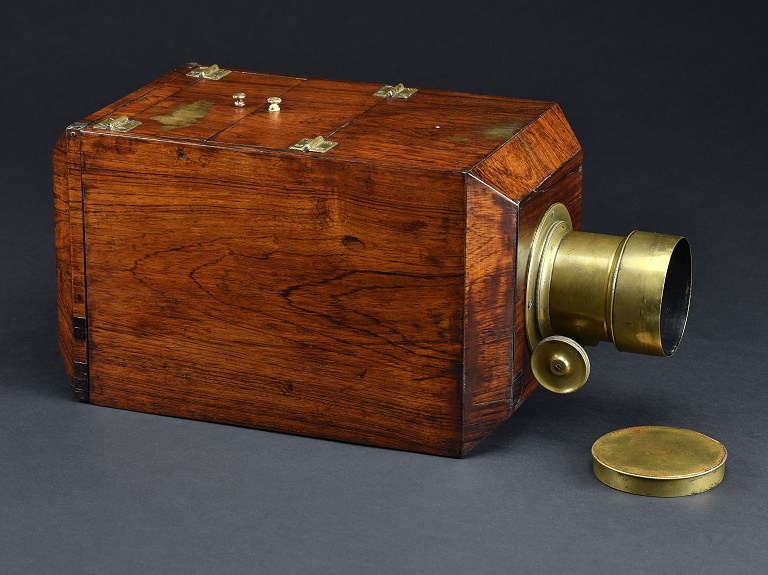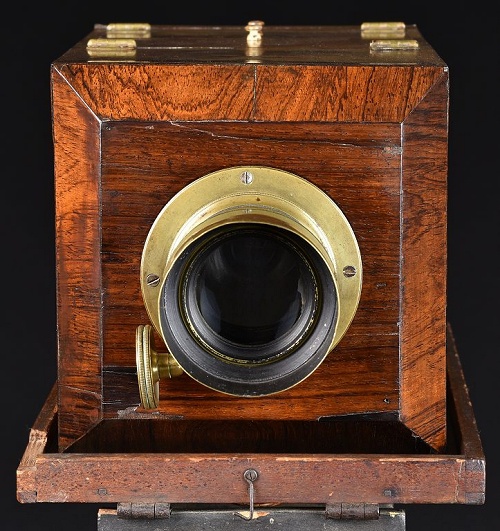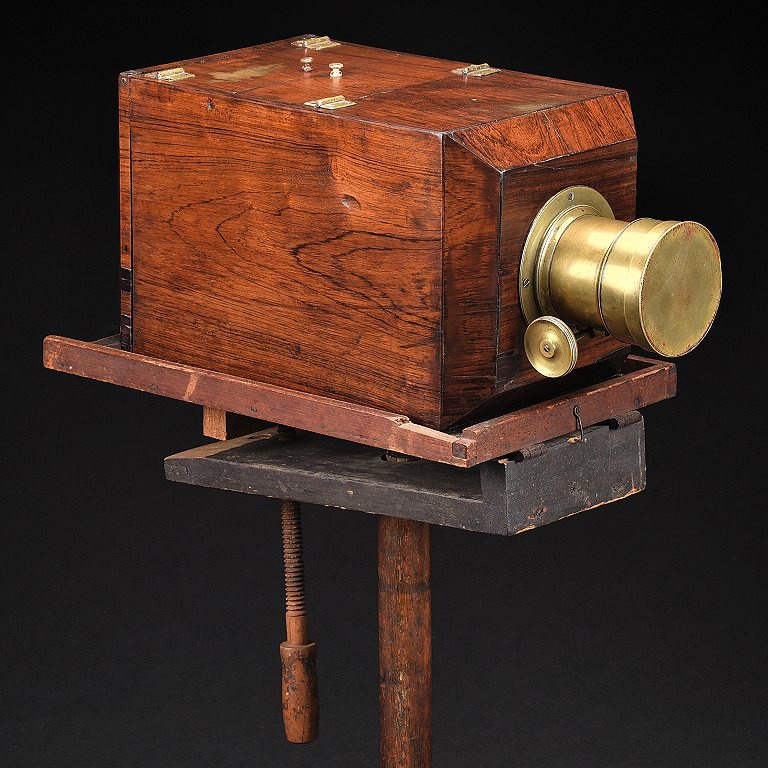|
|





Copyright ©2017 by Rob Niederman - ALL RIGHTS RESERVED
Return to the Solid Body & Box Cameras page
Capturing light to create permanent images is the ultimate goal
of photography, and some of the most interesting early
equipment built to capture light was made during the first stage
of photographic technology - the daguerreotype era from 1839
to the early 1850s. Cameras of this time were often constructed
with the same care as fine furniture.
This ½-plate format (4¼ x 5½ inch) American daguerreotype camera nearly dates to the first decade of photography. While not the earliest American camera, the beautiful rosewood veneered body with distinctive corner chamfering was made from roughly 1845 to the early 1850s. It is unclear why corner chamfering was popular in the United States, yet this body pattern is considered by most collectors as the epitome of all daguerrian designs.
Daguerreotype cameras typically have heavier builds; and this American-Style Chamfered design has wood sides ranging from ½ inch to just over 1 inch in thickness. And a bit of trivia ... during this time, cameras were advertised as "boxes" and lenses referred to as "cameras". It's somewhat confusing when you think about it.
Daguerreotype apparatus was typically used for portrait work and petzval formula lenses are normally found with the cameras. The camera and petzval lens shown here are both unmarked, which is common. Although the maker is unknown, there are a limited number of references leading some researchers to believe these were made in Vienna for the American market. In one of his research papers, historian Nigel Russell notes that Henry H. Snelling, in his 1849 book The History of the Art of Photography, suggests that this style was copied from Voigtländer cameras that were being imported at that time.
This ½-plate format (4¼ x 5½ inch) American daguerreotype camera nearly dates to the first decade of photography. While not the earliest American camera, the beautiful rosewood veneered body with distinctive corner chamfering was made from roughly 1845 to the early 1850s. It is unclear why corner chamfering was popular in the United States, yet this body pattern is considered by most collectors as the epitome of all daguerrian designs.
Daguerreotype cameras typically have heavier builds; and this American-Style Chamfered design has wood sides ranging from ½ inch to just over 1 inch in thickness. And a bit of trivia ... during this time, cameras were advertised as "boxes" and lenses referred to as "cameras". It's somewhat confusing when you think about it.
Daguerreotype apparatus was typically used for portrait work and petzval formula lenses are normally found with the cameras. The camera and petzval lens shown here are both unmarked, which is common. Although the maker is unknown, there are a limited number of references leading some researchers to believe these were made in Vienna for the American market. In one of his research papers, historian Nigel Russell notes that Henry H. Snelling, in his 1849 book The History of the Art of Photography, suggests that this style was copied from Voigtländer cameras that were being imported at that time.
American-Style Chamfered Daguerreotype, c.1850
Unknown Maker (possibly made in Vienna)
Unknown Maker (possibly made in Vienna)
Bodies covered with polished rosewood veneer and corner
chamfering are unique to American daguerrian equipment.
This camera includes its original ground glass, a 1/4-plate wet plate holder adapted for the larger
body, and an early iron center stand with turned "acorn" legs. The holder has a 1/6-plate insert; a
popular image size for portraiture. Plate holders were made to fit into the body for portraits (the
long side of the image format was oriented vertically). For landscape photography, cameras such as
this were turned on their side.
Turned bone knobs serve as handles to open the top loading doors. Stands with tilting platforms held the cameras without the need for screws and sockets to keep them in place. Original stands with cast iron centers [yokes] to hold the wooden legs, such as the one shown here, are actually rarer than the cameras.
Photographers cherished lenses and took time to learn their imaging characteristics. Favorite lenses were often kept and mounted on newer "boxes" (bodies) when the older bodies wore out. Yet it's amazing to consider the good-to-excellent condition of many of these earlier rosewood veneered cameras in spite of their harsh photographic life.
Given how cameras were often treated, and possibly discarded, this particular camera is special because it was a workhorse that continued to be used into the 1850s for wet plate photography as the daguerreotype process was loosing favor. Some collodion or silver nitrate staining appears on the top body veneer and inside the plate holder, probably from the photographer shooting ambrotypes. Fortunately wet plate chemistry, which can be caustic, didn't significantly decompose the wood beyond some surface staining.
Turned bone knobs serve as handles to open the top loading doors. Stands with tilting platforms held the cameras without the need for screws and sockets to keep them in place. Original stands with cast iron centers [yokes] to hold the wooden legs, such as the one shown here, are actually rarer than the cameras.
Photographers cherished lenses and took time to learn their imaging characteristics. Favorite lenses were often kept and mounted on newer "boxes" (bodies) when the older bodies wore out. Yet it's amazing to consider the good-to-excellent condition of many of these earlier rosewood veneered cameras in spite of their harsh photographic life.
Given how cameras were often treated, and possibly discarded, this particular camera is special because it was a workhorse that continued to be used into the 1850s for wet plate photography as the daguerreotype process was loosing favor. Some collodion or silver nitrate staining appears on the top body veneer and inside the plate holder, probably from the photographer shooting ambrotypes. Fortunately wet plate chemistry, which can be caustic, didn't significantly decompose the wood beyond some surface staining.
Front view showing veneer and chamfering detail.